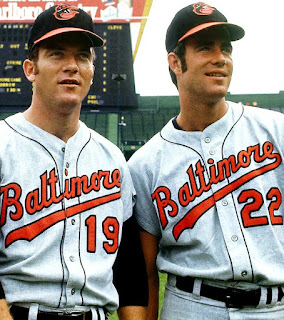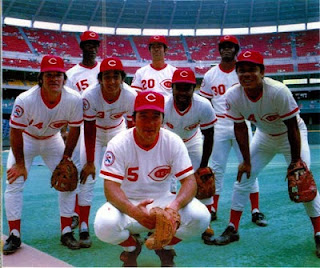Part 2 of the Ruth Bracket Preview
RUTH BRACKET
 |
| Dave McNally (left) and Jim Palmer (right), two of Baltimore's young guns. |
1969 Baltimore Orioles (3)
Vs.
2008 Tampa Bay Rays (14)
The 1969 Baltimore Orioles are a historic team for all the wrong reasons, it was their 1966 team that would give the franchise it's first American League pennant in 21 seasons (while they were the 1944 St. Louis Browns), and it's first World Championship. The 1969 team would lose to the "Amazing" New York Mets, in one of the biggest upsets in Major League Baseball history.
So can the 2008 Tampa Bay Rays pull off a little magic of it's own? Led my a team of youngsters, the Rays are the tournament's lone representative of Florida, while the Orioles' franchise has the 1969 and 1983 teams, plus 44' Browns in the tournament.
The Orioles are a well-rounded force led by a great rotation, solid bullpen, and a tough lineup led by Boog Powell and Frank Robinson, as Brooks Robinson's gold glove at third base anchors the team's defense.
The Rays have a mix of young stars with Evan Longoria, Carlos Pena, Carl Crawford, and B.J. Upton, in which the team's rotation came together in 2008 for the Rays to finally make that jump to contender. The Rays would go on to lose the World Series in 2008 to the Philadelphia Phillies.
PREDICTION: The Baltimore Orioles will show that they are one of the better teams in the tournament, the rotation and bullpen should be the difference; then again the Rays' lineup is far superior to the 1969 Mets lineup of the Mets team that pulled off their "Amazing" feat. Each game will be a battle, but the O's will win the series 3-1.
1942 St. Louis Cardinals (6)
Vs.
1927 Pittsburgh Pirates (11)
The 1942 St. Louis Cardinals were a tough team to place in the entire rankings from (#1-to-#64) for so many reasons, their lineup was not much better actually then the "Dead-ball Era", the team's OPS was relatively low at .717 with 60 home runs. The team however, did outscore their opponents by a difference of 273 runs, while winning 106 games (.688 pct.)! I finally had them placed at #24, only the tournament will say how tough this team actually is.
Stan Musial has just arrived onto the scene, 42' was his first full season, and he is yet to be the superstar HOF'er he will turn out to be. His season OPS is only .887, while batting .315 with 10 HRs (2nd on team) and 72 RBI. The team's best player was Enos Slaughter who led the team with 13 HRs & 98 RBI, while batting .318. The team also has a pretty good pitching staff that posted a team ERA (that led the National League) of 2.55!
The 1927 Pittsburgh Pirates was a team similar in pop (with 54 HRs), much better OPS (.773), but had a 3.66 team ERA. The team was led by Pie Traynor & the Waner brothers (Paul and Lloyd), Kiki Cuyler was an up-and-coming star, and the team had a 20 year-old rookie in Joe Cronin (who only played 12 games).
PREDICTION: This has the makings to be a close series, but I feel the rotation and pitching staff of the Cardinals makes a huge difference, it will be up to the Pirates defense and some lucky breaks to take this series. This series has the chances to bounce back and forth to interesting breaks, but in the end, I feel it will be the Cardinals winning this series 3-2.
 |
| MGR Harvey Kuenn with two future Hall-of-Famers in Molitor & Yount in 1982. |
1977 New York Yankees (7)
Vs.
1982 Milwaukee Brewers (10)
The
1977 New York Yankees signally the beginning of the Steinbrenner era Yankees, and all the drama that followed this crew from
Billy Martin to
Reggie Jackson, will face off against the
1982 Milwaukee Brewers - "Harvey's Wallbangers"!
Two lineups with plenty of offense, the Yankees and Brewers match up really well in OPS .791 to .792, while both teams slugged plenty of HR's -- 184 (Yankees) and 216 (Brewers) while both match-up in speed with 93 (Yankees) and 84 (Brewers) stolen bases.
The difference will come down to the pitching. The rotation for the Yankees was more consistent, led by
Ron Guidry's 16-7 record, 2.82 ERA & 176 K's.
Ed Figueroa (16-11, 3.54 ERA) ,
Don Gullett (14-4, 3.58 ERA & 116 K's) and
Mike Torrez (14-12, 3.82 ERA) fill out the rest of the rotation. The Brew Crew on the other hand, don't really have a legit #1 starter,
Pete Vuckovich leads the pack with a 18-6 record, and led the team with a 3.34 ERA & 105 K's), in which is followed by
Mike Caldwell (17-13, 3.91 ERA) and three starters with ERA's over 4.00 in
Moose Haas (11-8, 4.47 ERA & 104 K's),
Bob McClure (12-7, 4.22 ERA & 99 K's), and
Randy Lerch (10-7, 4.69 ERA).
PREDICTION: I'm going to take a safe bet and stretch this to five games in favor of the Yankees. I can see Milwaukee pulling the series off since the team's match-up really well, and also the fact that it is a #7 vs. #10 match-up, so this wouldn't be a shocker if the "Brew Crew" moves on... but I have a difficult time looking at the rotations, thinking that Milwaukee's rotation won't come back and bite them in the butts.
.jpg) |
| The Giants got to be thinking with a little fear -- "Do we really have to play these guys?!" |
1975 Cincinnati Reds (2)
Vs.
1937 New York Giants (15)
The "Big Red Machine" still holds up as one of the greatest baseball dynasties ever, the team finally broke through in 1975 with a World Championship over the Boston Red Sox. The team would go on to repeat in 1976 over the New York Yankees.
The team shined with future Hall-of-Famers Joe Morgan, Johnny Bench, Tony Perez, and Pete Rose... oh wait! wait! That's right due to baseball's ignorance, the all-time Hits leader (Rose) is still being overly-punished while baseball has no problem celebrating questionable characters such as Ty Cobb, Cap Anson, Barry Bonds and Babe Ruth (Yes, I said it! -- Babe Ruth). Plus the team was managed by the great Sparky Anderson.
The 1937 New York Giants are led by Mel Ott and Carl Hubbell (also both in the Hall), but this team even fails to match-up to prior Giants' teams, and will have to face off against a superior team as the Reds, just like they had to do with the 37' Yankees.
PREDICTION: The Cincinnati Reds will win this series, 3-1. Hubbell may be able to give Giants a victory, but they will have to face off against the "machine" who are loaded.
***This ends the Preview for the RUTH BRACKET***








.jpg)



